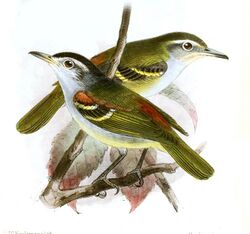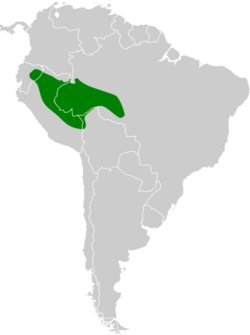Biology:Chestnut-shouldered antwren
| Chestnut-shouldered antwren | |
|---|---|

| |
| File:Terenura humeralis - Chestnut-shouldered Antwren XC249055.mp3 | |
| Scientific classification | |
| Domain: | Eukaryota |
| Kingdom: | Animalia |
| Phylum: | Chordata |
| Class: | Aves |
| Order: | Passeriformes |
| Family: | Thamnophilidae |
| Genus: | Euchrepomis |
| Species: | E. humeralis
|
| Binomial name | |
| Euchrepomis humeralis (Sclater, PL & Salvin, 1880)
| |

| |
| Synonyms | |
|
Terenura humeralis | |
The chestnut-shouldered antwren (Euchrepomis humeralis) is a species of bird in subfamily Euchrepomidinae of family Thamnophilidae, the "typical antbirds". It is found in Bolivia, Brazil , Ecuador, and Peru.[2]
Taxonomy and systematics
The chestnut-shouldered antwren was described by the English ornithologists Philip Sclater and Osbert Salvin in 1880 and given the binomial name Terenura humeralis.[3] There it remained until the current genus Euchrepomis was created in 2012 following phylogenetic analysis.[4]
The chestnut-shouldered antwren is monotypic.[2]
Description
The chestnut-shouldered antwren is 9.5 to 11 cm (3.7 to 4.3 in) long and weighs about 7 to 8 g (0.25 to 0.28 oz). The sexes have different plumage. Adult males have a whitish supercilium and a thin dark line through the eye on an otherwise pale gray face. Their crown and nape are black, their back greenish olive, their rump rufous-chestnut, and their uppertail coverts and tail grayish olive. Their wing coverts are blackish gray with whitish tips that form two bars on the closed wing, their flight feathers olive-tinged blackish gray with pale olive-yellow edges, and the bend of the wing rufous-chestnut. Their throat and breast are pale gray and their belly and undertail coverts are pale yellow. Adult females have a olive-brown crown, nape and eyeline, a pale gray supercilium, and dark olive-brown wings with at most a trace of chestnut at the bend.[5][6]
Distribution and habitat
The chestnut-shouldered antwren is found from eastern Ecuador and eastern Peru south of the Rio Napo south into northwestern Bolivia and east in Brazil through northern Rondônia and into Amazonas state as far as the Rio Madeira. It inhabits the subcanopy and canopy of terra firme and drier floodplain tropical evergreen forest.[5][6][7]
Behavior
Movement
The chestnut-shouldered antwren is believed to be a year-round resident throughout its range.[5]
Feeding
The chestnut-shouldered antwren feeds on arthropods, though details of its diet are lacking. It typically forages in pairs or small family groups that usually join mixed-species feeding flocks. It forages almost entirely in the forest canopy, acrobatically gleaning prey from leaves and the ends of branches.[5][6][7]
Breeding
Nothing is known about the chestnut-shouldered antwren's breeding biology.[5]
Vocalization
The chestnut-shouldered antwren's song is "very high, thin, slightly descending, gradually accelerating to a 'fuh-fuh-weet-weet-d-rrr' rattle".[7]
Status
The IUCN has assessed the chestnut-shouldered antwren as being of Least Concern. It has a very large range but its population size is not known and is believed to be decreasing. No immediate threats have been identified.[1] It is considered fairly common in most of its range and occurs in several protected areas.[5]
References
- ↑ 1.0 1.1 BirdLife International (2016). "Chestnut-shouldered Antwren Euchrepomis humeralis". IUCN Red List of Threatened Species 2016: e.T22701653A93842110. doi:10.2305/IUCN.UK.2016-3.RLTS.T22701653A93842110.en. https://www.iucnredlist.org/species/22701653/93842110. Retrieved 26 December 2023.
- ↑ 2.0 2.1 Gill, Frank; Donsker, David; Rasmussen, Pamela, eds (July 2023). "Antbirds". https://www.worldbirdnames.org/new/bow/antbirds/.
- ↑ Sclater, Philip L.; Salvin, Osbert (1880). "On new birds collected by Mr. C. Buckley in Eastern Ecuador". Proceedings of the Zoological Society of London (2): 155–161 [159]. https://biodiversitylibrary.org/page/28522287.
- ↑ Bravo, G.A.; Remsen, J.V.; Whitney, B.M.; Brumfield, R.T. (2012). "DNA sequence data reveal a subfamily-level divergence within Thamnophilidae (Aves: Passeriformes)". Molecular Phylogenetics and Evolution 65 (1): 287–293. doi:10.1016/j.ympev.2012.06.016.
- ↑ 5.0 5.1 5.2 5.3 5.4 5.5 Zimmer, K. and M.L. Isler (2020). Chestnut-shouldered Antwren (Euchrepomis humeralis), version 1.0. In Birds of the World (J. del Hoyo, A. Elliott, J. Sargatal, D. A. Christie, and E. de Juana, Editors). Cornell Lab of Ornithology, Ithaca, NY, USA. https://doi.org/10.2173/bow.chsant1.01 retrieved December 26, 2023
- ↑ 6.0 6.1 6.2 Ridgely, Robert S.; Greenfield, Paul J. (2001). The Birds of Ecuador: Field Guide. II. Ithaca: Cornell University Press. pp. 414. ISBN 978-0-8014-8721-7.
- ↑ 7.0 7.1 7.2 van Perlo, Ber (2009). A Field Guide to the Birds of Brazil. New York: Oxford University Press. pp. 244. ISBN 978-0-19-530155-7.
Wikidata ☰ Q27075125 entry
 |


